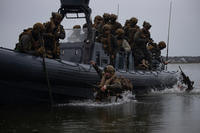The Navy's troubles with keeping ships maintained and at sea have only worsened in the last several years, resulting in a less-ready force when the service is looked to as the first line of defense against China, the Government Accountability Office reported this week.
The service's inability to keep ships running is also having serious effects on the operations of the Marine Corps, which relies on Navy ships to transport and position them near mission areas, to the frustration of officials in that branch.
Overall, the watchdog agency report released Tuesday found that while the Army and Marines have managed to keep up or increase the readiness of their troops, the Navy's sea forces have been on the decline -- with some areas worsening for more than a decade.
Read Next: Murdered or Missing: The Army Stands Up a Cold Case Unit to Tackle Unsolved Crimes
"We found in January 2023 that sustainment challenges worsened from fiscal year 2011 through 2021 for 10 ship classes we reviewed," according to the GAO report.
The challenges included growing maintenance delays, an increase in the number of platforms being raided for spare parts, and more and more ships reporting serious breakdowns and failures.
While the Navy always aims for no delays in the maintenance of their ships, government investigators instead found that ship repair and upkeep delays grew from an average of five days in 2011 to 19 in 2021.
Meanwhile, the agency found that "over the same time frame, there was a decrease in steaming hours."
Compounding the problem has been a shortage of spare parts for ships. Citing supply chain shortfalls for specific parts, Navy officials have been resorting to reusing or moving parts from one ship to another to keep them running.
Investigators found that the average number of cannibalizations per ship increased every year from 2015 to 2021.
Finally, between 2011 to 2021, more and more ships were reporting serious parts failures, the report found.
The Wasp-class amphibious assault ships were one of the biggest problems for the Navy, which, according to investigators, saw an increase of about 43 such failures from fiscal year 2011 to fiscal year 2021.
The amphibious assault ships are instrumental in transporting Marines to places around the world, where they can carry out missions like disaster relief or civilian evacuations, and the Navy's failure to keep the ships running has rankled the Marine Corps.
One Marine Corps official told Military.com not only was the Navy "failing its national security mission by not maintaining these ships properly" but, frustratingly, "leadership of the Navy seems content on providing the Marine Corps the 'minimum requirement' and they aren't even doing that well."
Publicly, even the Marine Corps' top general has expressed serious concerns.
Last week Commandant Gen. David Berger told Congress that he had serious regrets over the fact that Marines were not available to help in two major crises in recent months because of a lack of available Navy ships to position units in nearby waters.
"Places like Turkey or, the last couple of weeks, in Sudan -- I feel like I let down the combatant commander," Berger told members of the House Armed Services Committee on April 28.
Many of the amphibious ships in question are showing their age, and there has been tension both in the Pentagon and on Capitol Hill on the path forward for both the Navy and the Marines, who rely on the vessels to fulfill their missions.
In this year's budget proposals, the Navy suggested that it would drop its amphibious ship numbers below a 31-ship threshold by retiring older dock landing ships while pausing orders of the replacement San Antonio-class amphibious transport dock ships -- a move that the Marine Corps official noted would be violating the law.
Navy Secretary Carlos Del Toro told Congress last week that "there is unquestionably a need for heavy lift when it comes to fulfilling the Marine Corps responsibilities," but the service has "some [dock landing ships], for example, that cannot be made operationally available to fulfill the requirements that we need."
The report goes on to say that the path forward for the Navy is challenging.
"Addressing ship and submarine maintenance delays, backlogs, and other sustainment challenges will be difficult given the poor condition of infrastructure at the Navy's four public shipyards," the report said.
Although the Navy began a 20-year, $21 billion effort to revitalize its shipyards -- known as the Shipyard Infrastructure Optimization Plan -- the report also notes that there have already been $1.6 billion in cost overruns and a slipping of deadlines by three years.
"Completely implementing the Shipyard Infrastructure Optimization Plan will involve funding well above the levels allocated in recent years for shipyard infrastructure, as well as significant planning and sustained management attention over 20 years," the report said.
-- Konstantin Toropin can be reached at konstantin.toropin@military.com. Follow him on Twitter @ktoropin.













